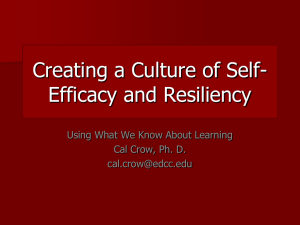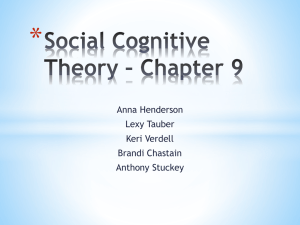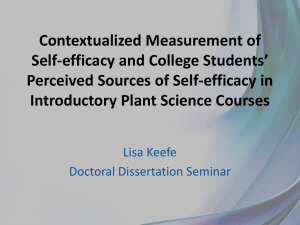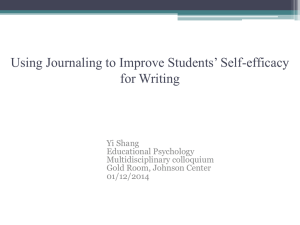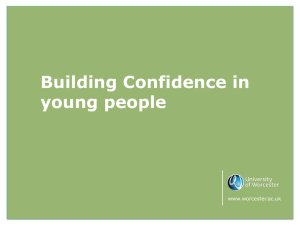Increasing Self-Efficacy to Enhance Learning and Motivation
advertisement
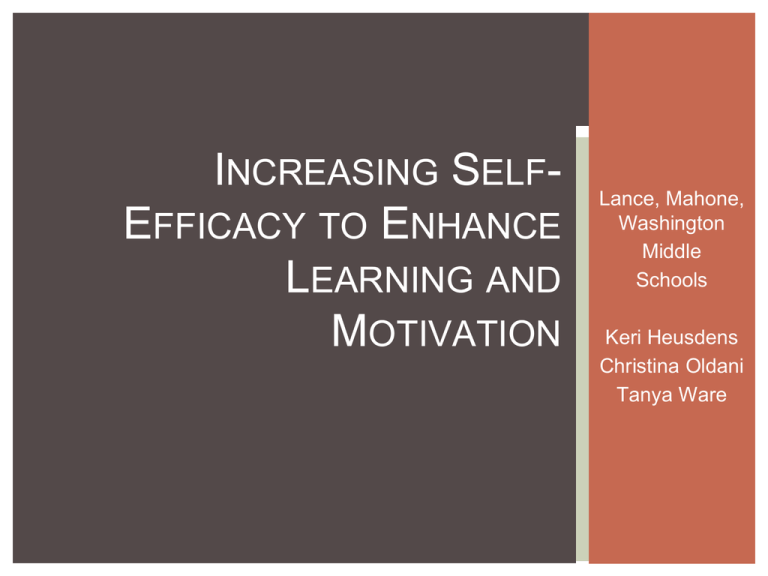
INCREASING SELFEFFICACY TO ENHANCE LEARNING AND MOTIVATION Lance, Mahone, Washington Middle Schools Keri Heusdens Christina Oldani Tanya Ware CHALLENGE If students have a low sense of self-efficacy, their ability to be self-directed and successful learners is significantly diminished. They will attribute successes and failures to luck rather than the amount of effort they put into the task. WHAT IS SELF EFFICACY? One’s belief in their capability to perform in ways that allow them to influence the events that affect their lives. People with a high degree of selfefficacy approach difficult tasks as challenges to overcome, instead of problems to be avoided, and sustain their efforts even in the face of failure. REFLECT ON YOUR OWN EXPERIENCES • • Do you feel that you have the ability to teach every student? • Have you ever lost faith in your ability to meet the needs of all students due to factors beyond your control? • How often have you found yourself giving up on challenging professional tasks? DO YOUR STUDENTS... • Act out, refuse to work, or shut down when an activity is difficult? • Say they can't complete assignments? • Give up quickly? • Lose faith in their ability to perform a task? They are lacking self-efficacy SOURCES OF SELF-EFFICACY There are four sources of self-efficacy: o Mastery Experiences o Vicarious Experiences o Social Persuasions (feedback) o Psychological and Emotional States CAUSES OF POOR SELF-EFFICACY Lack of successful experiences Not providing opportunity for mastery Lack of encouragement and support High stress or anxiety Competitive environment Inadequate feedback STRATEGIES TO IMPROVE STUDENT SELF-EFFICACY Use moderately-difficult tasks Use peer models Capitalize on students’ interests Allow students to make choices Encourage students to try Give frequent, focused feedback Encourage accurate attributions DESIRED OUTCOMES • Teachers and students will have increased self-efficacy measured by pre and post surveys. • Student learning will increase. • School morale and motivation and effort will increase. • Quality of student work will increase. HOW ARE WE GOING TO GET THERE? WE WILL: • Complete pre and post survey • Teach goal setting to students • Write goals using one (per semester) of the six root causes of low self-efficacy • Reflect on goals (Journal) • Share students’ progress (My Big Campus/Meetings) • Implement self-efficacy learning activities • Teach book study lessons (provided by Delta Teams) to advisories. DELTA TEAM WILL: • • • • • • Administer and analyze survey Present goal setting format Provide prompts for goal reflections Develop advisory activities for teachers to use Manage My Big Campus Group Analyze program • Feedback/Observation • Case Study • School Reports • Communicate self-efficacy strategies with families STUDENTS WILL: • Complete pre and post self-efficacy survey • Set goals • Reflect on goals (Journals) • Discuss progress with teachers and/or peers • Complete activities that promote self-efficacy • Participate in advisory book study and corresponding activities. ACTIVITIES • Teacher self-efficacy pre-survey • Student self-efficacy pre-survey • Students set goals (1 big goal per quarter with smaller goals that are reflected on weekly) • Teachers set goals (2 during the year) • Student journaling (with prompts from Delta team) • Teacher journaling (with prompts from Delta team) • Monthly advisory activities (provided by the Delta team) • Teacher self-efficacy post-survey • Student self-efficacy post-survey BOOK STUDY I Can’t Accept Not Trying: Michael Jordan on the Pursuit of Excellence 6 chapters: Goals Fears Commitment Teamwork Fundamentals Leadership BOOK STUDY An excerpt from: I Can’t Accept Not Trying: Michael Jordan on the Pursuit of Excellence I approach everything step by step....I had always set short-term goals. As I look back, each one of the steps or successes led to the next one. When I got cut from the varsity team as a sophomore in high school, I learned something. I knew I never wanted to feel that bad again....So I set a goal of becoming a starter on the varsity. That’s what I focused on all summer. When I worked on my game, that’s what I thought about. When it happened, I set another goal, a reasonable, manageable goal that I could realistically achieve if I worked hard enough....I guess I approached it with the end in mind. I knew exactly where I wanted to go, and I focused on getting there. As I reached those goals, they built on one another. I gained a little confidence every time I came through. GOAL SETTING • Student goal setting • Teacher goal setting • Reflecting on goals through journaling CLASSROOM ACTIVITIES • Lessons on self-efficacy • Class discussions • Promoting school wide self-efficacy (posters) HOW DO WE KNOW THIS IS GOING TO WORK? • The connection between self-efficacy and achievement get stronger as students get older. • If we want high student achievement it is essential we start stressing self-efficacy early. HOW DO WE KNOW THIS IS GOING TO WORK? Achievers set goals and have a higher sense of self-efficacy. (Robert Wood and Edwin Locke, 1987) Underachievers do not set goals and if they do they are set at unattainable levels. HOW DO WE KNOW THIS IS GOING TO WORK? When students are taught to take larger, more distant goals and break them into manageable steps, they make faster progress in attaining skills or content, they are able to self-regulate, and they have greater self-efficacy. (Albert Bandura and Dale Schunk, 1981) REFERENCES • Afolabi, K. A. (2010, September 1). Relationship of Self-Efficacy Beliefs of Urban • • • • • • Public School Students to Performance on a High-Stakes Mathematics Test. Open Access Dissertations. Amherst, MA, USA: University of Massachusetts. Bandura, A. (1997). Self-Efficacy: The Exercise of Control. New York: W.H. Freeman and Company. Kirk, K. (2012, July 19). Self-Efficacy: Helping Students Believe in Themselves. Retrieved July 23, 2012, from The Science Education Resource Center at Carleton College: http://serc.carleton.edu/NAGTWorkshops/affective/efficacy.html Pellino, K. (2003). The Effects of Poverty on Teaching and Learning. Retrieved July 31, 2012, from Teachnology: http://www.teach-nology.com/Articles/teaching/poverty/ Siegle, D. (2007). Increasing Student Mathematics Self-Efficacy Through Teacher Training. Journal of Advanced Academics , 278-312. Siegle, D. (2000). Self-Efficacy Strategies. Retrieved July 23, 2012, from Self-Efficacy Intervention. Zimmerman, B., & Cleary, T. (2006). Adolescents' Development of Personal Agency: The Role of Self-Efficacy Beliefs and Self-Regulatory Skill. In F. Pajares, & T. Urdan, Self-Efficacy Beliefs of Adolescents (pp. 45-69). Charlotte, NC: Information Age Publishing.

